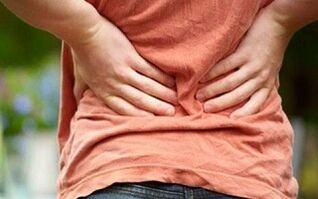
We're sure you've read and heard that low back osteoporosis often affects bankers and office workers, programmers, and representatives for strenuous physical labor. This is true, but the whole truth is that today it is difficult to find at least one type of activity unrelated to the risk of developing this disease.
Why so? Low-back osteoporosis is a "tax on going straight, " a tribute that each of us pays to nature. The reason for degenerative changes in the cartilage tissue of the disc lies not in an increase in the load on its nuclear spinal cord, but to the peculiarity of the blood supply to these structures.
Around the 20th year of life, the arteries that feed the cartilaginous tissues of IVD in adolescence are wiped out, and for all the remaining years, the marrow nucleus and the ring-shaped fibrosis receive nutrients only through diffusion. Canopy, and this is obviously not enough! Trace elements, polysaccharides, amino acids and other structural components enter the cell chondrocytes (the cell's interstitial synthesis cells) in extremely limited quantities, creating fertile soil for the disturbance process. development.
During our career, we regularly throw seeds into this fertile land. We sit in the wrong posture, lift weights incorrectly, move a bit, and spend a lot of time behind the wheel or behind a computer screen. All other things are equal, such a form of physical activity "will disappear with us", but given the limited supply of the cartilage structure in IVD, degenerative processes will inevitably develop. development.
How is bone necrosis in the lower back manifested?
The first manifestation of lumbar necrosis is pain syndrome. As a rule, for the first time a "lucky man" had a sharp pain in his back stabbed through the body with a dagger. The pain occurs after accidentally twisting the trunk, tilted, or after hypothermia. There is no way to endure such pain - it actually squeezes a person with his hand and binds his feet to the bed.
What changes occur in the spine against the background of pain syndrome? To relieve pain, the nervous system sends stimulation signals to the deep muscles of the back. Increasing muscle tone reduces mobility in the affected part of the spine, which over time reduces the severity of pain. In the future, myofixation no longer performs a compensatory function, and such muscle tone imbalances only aggravate pain.
When examining such a patient, the neurologist will detect signs of fixed syndrome, or objective symptoms of the disease - static and dynamic changes. Because of static changes in osteoporosis of the lower back, we refer to the smoothing or enhancement of physiological curvature (scoliosis) and the appearance of the pathological curvature in the direction of pain (curvature). scoliosis). Dynamic symptoms of the disease are a strong limitation of mobility (until complete immobility) in the affected part.
All of these changes can be confirmed using spinal scans (x-rays of the spine) and more modern research methods such as computed tomography and MRI. The picture also showed a clinically significant decrease in the height of the disc in the PDS region, bulging of the eye, and bone tumors.
Treatment of bone necrosis in the low back
The fixed and pain syndrome combined with morphological signs on the diagnostic image form a complete picture of the vertebral syndrome, which is caused by osteoporosis in the lower back. The next question that we ask the doctors after completing the diagnostic phase is how to treat the disease?
Of course, it is not always the disease that needs to be treated but the patient, but we are not immune from philosophical discussions. And we will tackle the more pressing problems - we'll have to overcome pain syndrome first. To do this, we need drugs that have systemic and local effects, such as NSAIDs, corticosteroid hormones, muscle relaxants, and possibly even antidepressants. After the pain relief syndrome turns to conservative treatments.
If you have been diagnosed with necrosis of the lower back, the treatment will be long and you should be prepared for this both ethically and financially. It is not possible to completely remedy the disease, so with a certain frequency you will have to see a doctor until the end of the day.
The treatment algorithm is always individual and it is developed by the attending physician, who knows the history of the disease, we will only list possible treatment directions. Acupressure has a positive effect, with acupuncture at the top of the list. Some experts support scissors therapy, although other schools of chiropractic reject the technique. It is worth trying that massage therapy, you definitely need to include back exercises (LFK) in your rehabilitation program, you can also seek the help of a qualified chiropractor. .
90 cases out of 100 conservative treatments are enough to control the disease, the remaining 10 patients are prescribed surgical treatment. In the absence of an indication for absolute surgery (severe spinal dilatation, spinal stenosis), treatment with minimal invasive surgery is possible. If the degree of morphological change in the spine has reached a critical level, modern methods of resurfacing by implantation will be used.

























